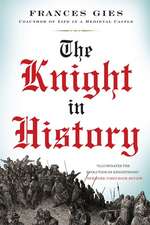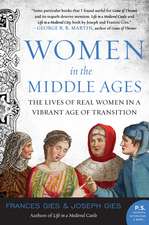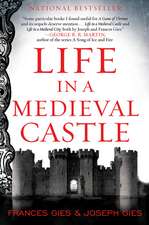Life in a Medieval City: Stories: Medieval Life, cartea 1
Autor Joseph Gies, Frances Giesen Limba Engleză Paperback – 31 aug 1981
| Toate formatele și edițiile | Preț | Express |
|---|---|---|
| Paperback (2) | 80.69 lei 6-8 săpt. | |
| HarperCollins Publishers – 25 ian 2016 | 98.30 lei 3-5 săpt. | |
| Harper Perennial – 31 aug 1981 | 80.69 lei 6-8 săpt. |
Preț: 80.69 lei
Nou
15.44€ • 16.12$ • 12.78£
Carte tipărită la comandă
Livrare economică 05-19 aprilie
Specificații
ISBN-10: 0060908807
Pagini: 288
Dimensiuni: 134 x 205 x 18 mm
Greutate: 0.22 kg
Ediția:Harper Colophon.
Editura: Harper Perennial
Seria Medieval Life
Textul de pe ultima copertă
Medieval history comes alive in Frances and Joseph Gies’s Life in a Medieval City, used as a research resource by George R. R. Martin in creating the world of A Game of Thrones.
Reissued for the first time in decades, Life in a Medieval City is the classic account of the year 1250 in the city of Troyes, in modern-day France. Acclaimed historians Frances and Joseph Gies focus on a high point of medieval civilization—before war and the Black Death ravaged Europe—providing a fascinating window into the sophistication of a period we too often dismiss as backward.
Urban life in the Middle Ages revolved around the home, often a mixed-use dwelling for burghers with a store or workshop on the ground floor and living quarters upstairs. A developed economy, focusing on textiles, farming, and financial services, could be found in the town center, where craftsmen competed for business while adhering to the guilds’ codes of conduct. There were schools for the children, though only boys could attend and the lessons were taught in Latin by a priest. The church was a hub of both religious and civic life; services were lively and filled with song, and baptisms and other special occasions brought neighbors together to celebrate. The weddings of wealthier townsfolk were lavish affairs full of song and dance and drinking that could sometimes last for weeks.
“An excellently written account of what is known of the life of medieval burghers.”—Library Journal
Recenzii
Descriere
"Some particular books I found useful for A Game of Thrones and its sequels deserve mention... Life in a Medieval Castle and Life in a Medieval City, both by Joseph and Frances Gies." —George R.R. Martin, author of the series A Song of Ice and Fire
Medieval history comes alive in Frances and Joseph Gies’s Life in a Medieval City, used as a research resource by George R. R. Martin in creating the world of Game of Thrones.
Reissued for the first time in decades, Life in a Medieval City is the classic account of the year 1250 in the city of Troyes, in modern-day France. Acclaimed historians Frances and Joseph Gies focus on a high point of medieval civilization—before war and the Black Death ravaged Europe—providing a fascinating window into the sophistication of a period we too often dismiss as backward.
Urban life in the Middle Ages revolved around the home, often a mixed-use dwelling for burghers with a store or workshop on the ground floor and living quarters upstairs. A developed economy, focusing on textiles, farming, and financial services, could be found in the town center, where craftsmen competed for business while adhering to the guilds’ codes of conduct. There were schools for the children, though only boys could attend and the lessons were taught in Latin by a priest. The church was a hub of both religious and civic life; services were lively and filled with song, and baptisms and other special occasions brought neighbors together to celebrate. The weddings of wealthier townsfolk were lavish affairs full of song and dance and drinking that could sometimes last for weeks.
“An excellently written account of what is known of the life of medieval burghers.”—Library Journal





















